Corrosion is a design nemesis for architects and builders. Yet it’s often not thought about to the extent it should be when designing high-value buildings. A recent report by the Australasian Corrosion Association estimated that corrosion costs Australia $78 billion annually, much of which is preventable.
A lack of design consideration to corrosion can cause serious problems ranging from property damage, significant remediation costs, premature maintenance and in worst cases, structural failure threatening lives. If the appearance of the material is affected, corrosion can reduce the overall value of the building. It also impacts sustainability, given that the longer a building lasts, the fewer materials, energy and resources are needed to maintain it.
While many are aware that corrosion can be a problem, few understand the science of why it occurs and what measures can be taken to prevent it.
What is corrosion?
Put simply, corrosion is a loss of material over time as it interacts with the environment around it. This loss may be through chemical or electrochemical mechanisms. The key thing to know is that refined metals want to corrode. Iron wants to become rust – it is its preferred state. By preventing corrosion, we’re fighting the natural process of the refined metal converting into a more chemically stable oxide.
While we can’t stop corrosion from happening (for the alloy in its raw state), there’s plenty we can do to prevent it from becoming an issue through the choices made at the design stage. One way is to look at materials not as standalone products, but more as a system of products and how they affect each other.
So, what are the most common forms of corrosion, and what are some ways architects can design around the problem?
Common forms of corrosion
Galvanic corrosion
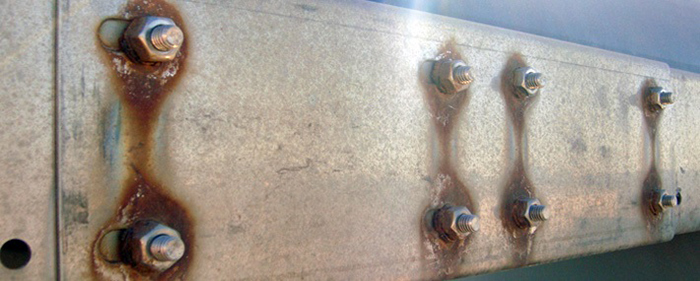
This is the most common type of corrosion which occurs when one metal comes into contact with a different type of metal in the presence of salt water. As all metals have different corrosion resistance properties called nobility, if you put two dissimilar metals in contact with each other, the less noble metal in the presence of an electrolyte (such as salty water) will always want to corrode faster. A galvanic current is created, similar to a battery between the anode (less noble metal) and the cathode (more noble metal). For this to occur, there needs to be an electrolytic solution, which is most commonly seawater.
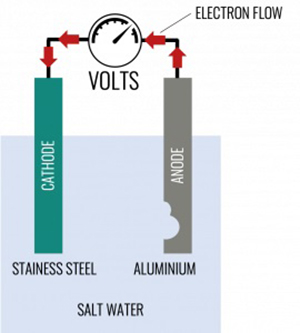
For example, aluminium on its own is typically slow to corrode. But screw it into a large piece of steel, and the aluminium is at much greater risk of corrosion – especially if in the presence of water in which salt is present – and of becoming an anode. The bigger the gap in nobility, the quicker the anode corrodes under the same conditions. To understand the degree to which two metals differ in nobility, consult a Galvanic Table.
Crevice corrosion
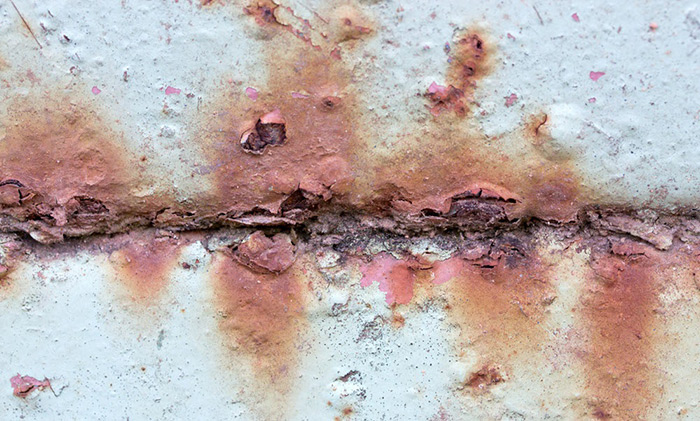
This is when two materials are in contact but are not 100% flat and form a gap or crevice between the two parts being joined. If water becomes trapped and pools between the two surfaces in the crevice, a localised form of corrosion can occur that tends to attack rapidly. It’s a hidden risk that people often don’t know about until the corrosion is severe and causes problems because it may not be visible on the surface.
Uniform corrosion
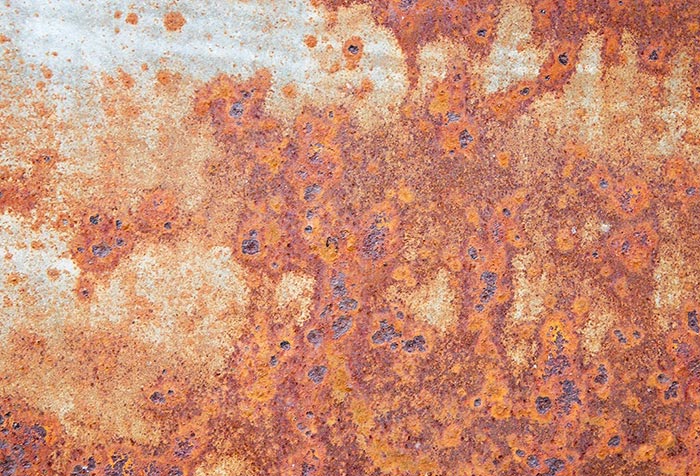
This is the third most common form of corrosion whereby over time a material reacts with moisture and oxygen in environment, with the loss of material occurring at a uniform rate mostly through oxidation.
Environments prone to corrosion
It’s commonly known that coastal locations tend to have a higher risk of corrosion than those inland due to the sea salt in the air. For this reason, corrosivity zones are generally defined in relation to their proximity to the ocean and the severity of coastal conditions.
There are six Australian Standard categories for corrosivity:
- (very low) for indoors
- (low) for arid/urban inland
- (medium) for coastal
- (high) for calm seashore
- (very high) for surf seashore
- (extreme) for severe surf shoreline
The standard method used for assessing these environments comes from ISO 9223 where standard size plates of carbon steel, aluminium, zinc and copper are placed in an environment and the loss of material after one year is assessed. The higher the rate of material loss, the more corrosive the environment. For example, a class 2 environment may cause a loss of less than 25 microns in one year, but in a class 4 environment, it could be as high as 80 microns per year. Note that there is not much correlation between a Neutral Salt Spray Test and the ISO 9223 standard. A Salt Spray test is better for comparing two materials where one has a known historical level of performance against corrosion.
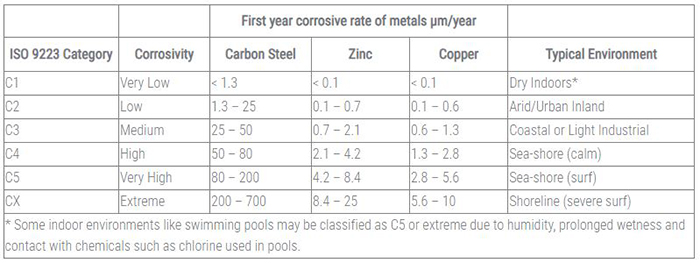
Airborne industrial chemicals such as sulphur and other solvents can cause very high corrosion rates, as can dust. Therefore, some rural, industrial and geothermal sites can experience higher corrosion rates. Weather also has a varying impact on corrosion – hot temperatures, humidity, rain and even the speed of rain can increase the risk of corrosion.
Other environments with increased risk of corrosion include poolside areas, due to the chlorine and dampness, and shaded areas that are either continuously damp or don’t receive rain that can wash away salt or chlorine deposits.
Regardless of the category rating, no two sites are exactly the same. It’s difficult to know how structures will react to the environment, which is why it’s important to take extra measures to plan for corrosion prevention and management.
Strategies to reduce vulnerability to corrosion
Strategy 1: Change the surface conditions of the material
Create thicker, harder surfaces: To counter uniform corrosion, you can use thicker materials that allow for some corrosion, or use coatings such as plating, galvanising (i.e., coating with a protective layer of zinc), powdercoating or anodising.
Washer: Utilise a nylon washer at the point of contact of two dissimilar metals to break up the connection. This vastly reduces the risk of rust forming.
Strategy 2: Lower the nobility gap
Use different metal proportions: Another method is to design products, so the more corrosion-resistant metal (such as steel) is smaller in proportion than the less resistant metal (such as aluminium). With galvanic corrosion, you end up with a galvanic current between the two metals, like a battery. By making one metal large and the other small, it reduces the current significantly, thereby reducing the amount of corrosion that can happen. We have also applied this principle to our clip design as another barrier of defence.
Strategy 3: Break the circuit
Apply powdercoating: To design around galvanic corrosion, the first form of defence is to create a barrier between the two materials and the environment. You can do this by applying powdercoating and making the surface ‘passive’. At Sculptform, all our clips come with powdercoating to separate the materials.
Strategy 4: Wash away the electrolytes
Consider drainage: To counter crevice corrosion, you need to consider how things lie and whether they can drain in the case of rain. This lowers the amount of electrolytes present.

Five steps for preventing corrosion in your next design
To minimise the risk of corrosion, we recommend always following these steps:
- Know your corrosivity zone: Understand which corrosivity zone you are building in as listed in AS4312 – ‘Atmospheric corrosivity zones in Australia’. As soon as you’re able to tell your suppliers which category your building project is in, suddenly we’re all speaking the same language and can address it head-on. At Sculptform, we always ask our clients upfront for the rating as it changes everything about what we recommend for your design.
- Consider other corrosion risks: Understand that the corrosivity category is not an absolute indication of the potential risk. For example, not everything 50km inland will be a category 3 or below. Similarly, not every beachfront is an extreme environment. If you are unsure, engage with a corrosion expert to assess vulnerabilities, or take up the offer by powdercoat companies such as Dulux to come and do an assessment of your site.
- Speak to your suppliers early in the design process about corrosion: Your suppliers can help give you ideas on how to design to avoid corrosion, such as how to keep metals apart or improve drainage, or recommend finishing options more suited to the corrosivity class. They can also help you design a simple yet effective maintenance program to ensure the longevity of the building. Be aware that for the extreme category 5, the powdercoating required may limit your colour palette. Also note, if you are required to increase the anodised layer in an extreme environment, it will increase your cost.
- Specify a manufacturer’s warranty with your powdercoatings: This means that the person who applies the powdercoating has to do it to the company’s warranty standard and verify it. This will be to the American Standard, which far exceeds the Australian Standard AS 3712, giving you greater confidence in your barrier for uniform corrosion. For example, a powdercoating applied to American Standard AAMA 2604 is best suited for a class 4 environment, meeting requirements more than 3 times that of the Australian Standard.
- Consider what maintenance will be required to keep corrosion at bay: In corrosive environments, some materials may have significant maintenance requirements such as washing down the system every few months to remove salt or chemical deposits on the surface. As described earlier, one strategy of defence is to wash away the electrolytes, which is essentially what maintenance is.
Design with corrosion in mind
One of the best ways of preventing corrosion is by factoring it into your design at the start of the project.
Making simple adjustments such as which materials you decide to use, avoiding crevices, creating barriers between metals and understanding the corrosive environment can go a long way in preventing corrosion and ensuring your project remains beautiful and strong for years to come.

